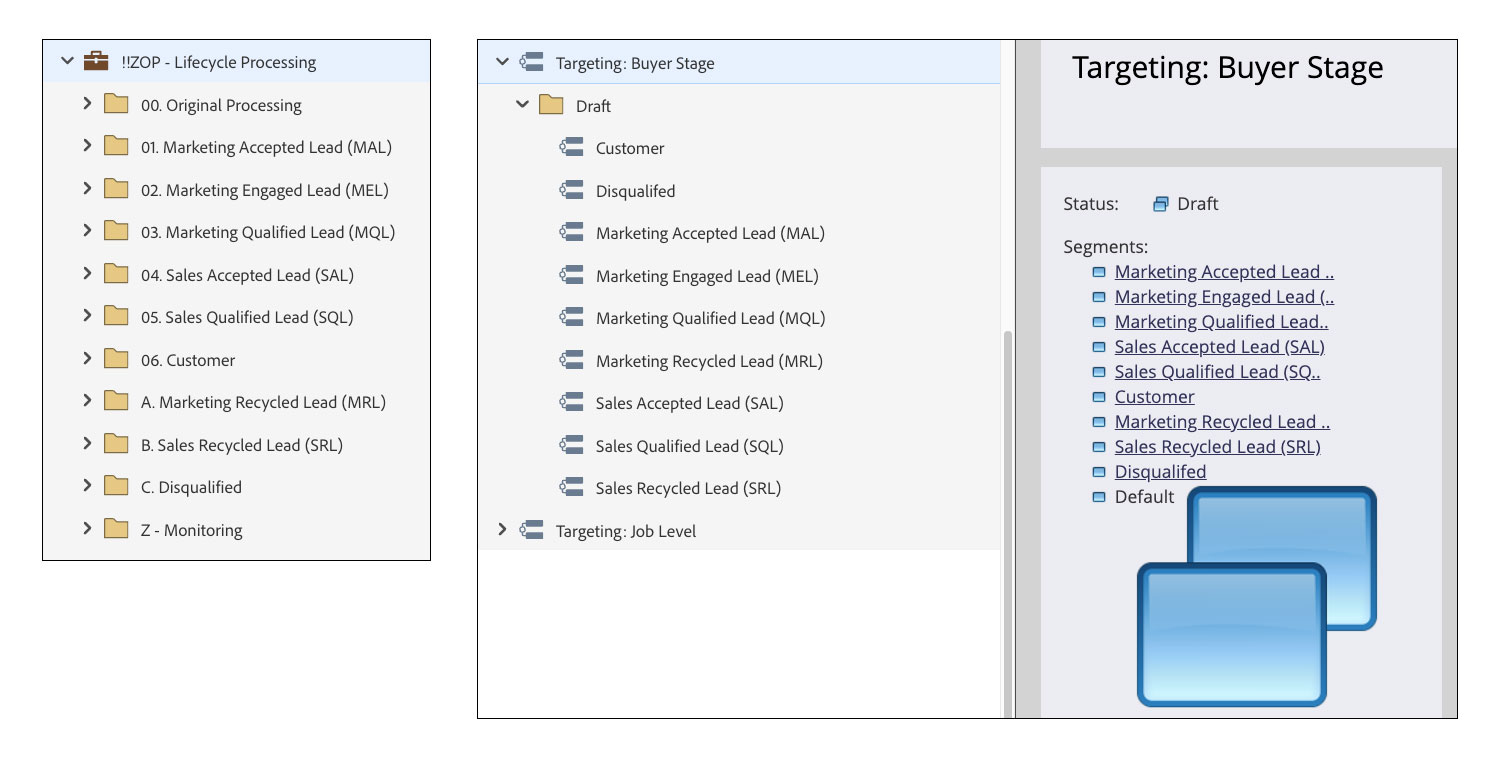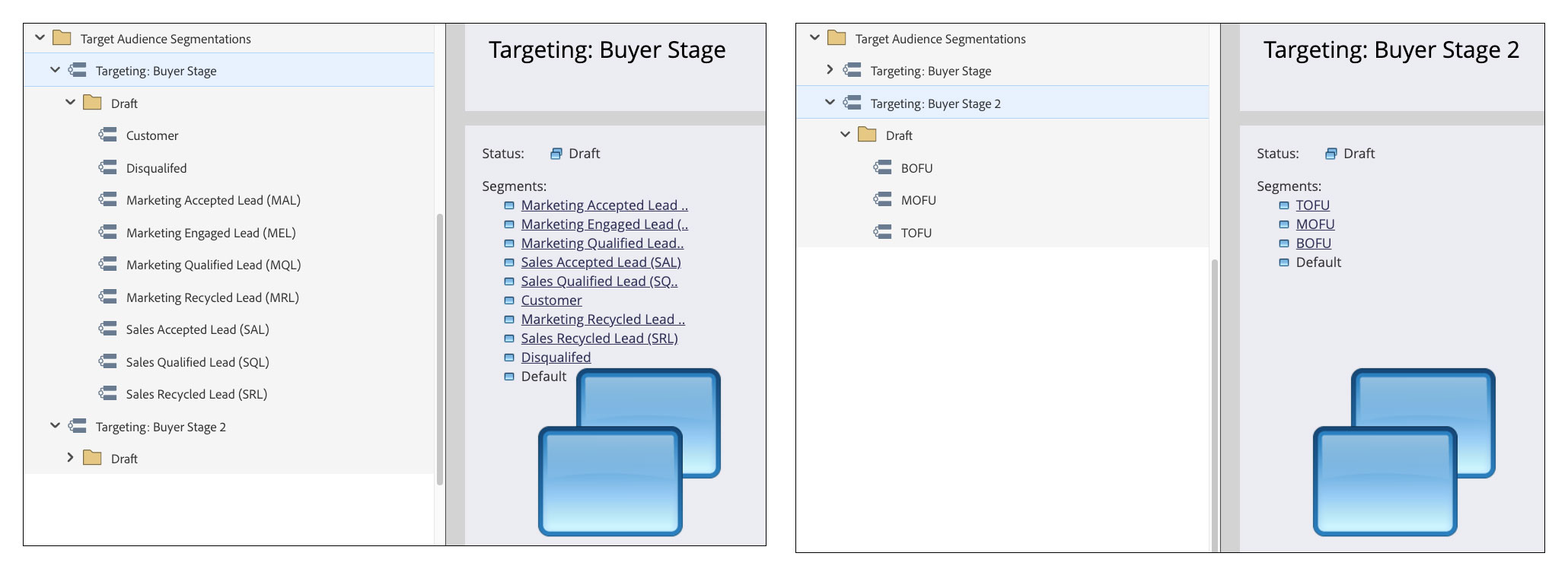Overview
Marketers should strive to build audience segmentations that are reflective of a person’s buying stage. While most marketing organizations are responsible for many metrics, such as lead generation, conversion to MQL, MQL to SAL, what becomes pipeline, and so forth, often their entire database is treated as a monolithic entity as if they are all at the same buying stage and the same level of engagement.
But we know that a brand new person in your database is not the same as a person who has already generated several marketing touchpoints, who is different still from one who is engaged with sales. And even if you are already informally using a combination of different lists, fields, and other criteria to roughly group people by buying stage, this can be prone to human error and inconsistency – plus, it’s often just a lot of work.
By profiling people by buying stage and having stages codified as segmentations, marketers can focus on developing customized messaging quickly and effectively and also creating robust nurture content to best target prospects – rather than spending time trying to figure out how to organize their audience and piece together different Smart Lists.
What does it mean to align your buying stages & audience segmentation?
Said simply, group your Marketo Engage database into buying stages by implementing a Lead Lifecycle program, and then use your distinct lifecycle stages to create a buying stage audience segmentation. From here, you’ll be able to rapidly scale marketing campaigns, and better target your marketing messaging towards each distinct cohort with their own specific needs. Marketing objectives are frequently aligned with buying stage outcomes, such as lead volume, conversion rates, and lead or pipeline velocity – and your audience segmentations should be too.

Equip your marketers and scale your operations through buying stage audience segmentations
Building audience segmentations aligned with buyers’ stages makes it easier for marketing managers to effectively complete their campaign planning, select the right audience criteria and streamline campaign setup. It eliminates the amount of manual effort and the complexity of the logic required to target the right audience.
Instead of having to sort through different fields, some of which may not have the correct data, a marketer can streamline their work. After all, it is easier to create Smart Lists for email sends using a filter of the segmentation name, where the segment equals whatever buying stage they want to market to. They can also take advantage of dynamic content when using segments, allowing for further scalability.
This also equips marketers with the foundation to nurture their audience and meet them where they are, instead of simply sending generic and “blast”-type content.
When should you embark on this type of project?
As soon as possible. Lead management efforts such as building a Lead Lifecycle program and then subsequently aligning your buying stages with an audience segmentation is something to start thinking about as soon as you have distinct lifecycle stages – or buying stages – identified. Even if you do not yet even have these stages mapped out, you can still start with commonly used stages and customize them later as necessary.
How to get started
To align buying stages and audience segmentations, you should:
1. Build out segmentations based on your desired buying stages.
You have a few options here:
- Build where each lifecycle stage has a corresponding audience segment. This is best if you have minimal lifecycle stages.
- Group lifecycle stages into the commonly used Awareness, Consideration, and Decision categories or Top of Funnel (TOFU), Middle of Funnel (MOFU), and Bottom of Funnel (BOFU) stages. This can be helpful when you have many different lifecycle stages and want to group them into larger buckets.
Remember: each person can only be in one segment per segmentation.
2. Review your content and map to your buying stages.
How can you share this content in such a way that you are meeting with your audience where they land as far as their buying stage goes?
3. Evaluate your email communications and other marketing programs.
Where can you use a buying stage segmentation to simplify operations? One example is a newsletter where perhaps you typically send two slightly different versions: one to people who just entered your database, and another to those who have engaged repeatedly before, but who still haven’t made a purchase. Now, using your buying stage audience segmentations, you can create one newsletter – and then harness the power of dynamic content to customize different components based on the reader’s buying stage and how familiar they are with your business.
4. From there, you can plan how to leverage nurture programs in Marketo Engage and utilize these newly created audience segmentations.
By building segmentations that leverage key audience profile attributes, including current buying stages, it is far easier to build highly personalized and targeted marketing campaigns at scale.
Who should implement this type of lead management structure?
Anyone who can group their database into buying stages should strongly consider creating audience segmentations. Whether you are marketing towards consumers or other businesses, or you have a wide variety of offerings with multiple, different sales funnels, these segmentations can still be built out to provide an easy-to-use and scalable resource for your marketers.
Conclusion
All Marketo Engage users can benefit from creating audience segmentation based on their buyer stages. This will enable highly targeted campaigns, enhanced prospect profiling, and the increased ability to effectively craft marketing campaigns. It also reduces the amount of manual effort and brain power required to have to piece together several different Smart Lists.








